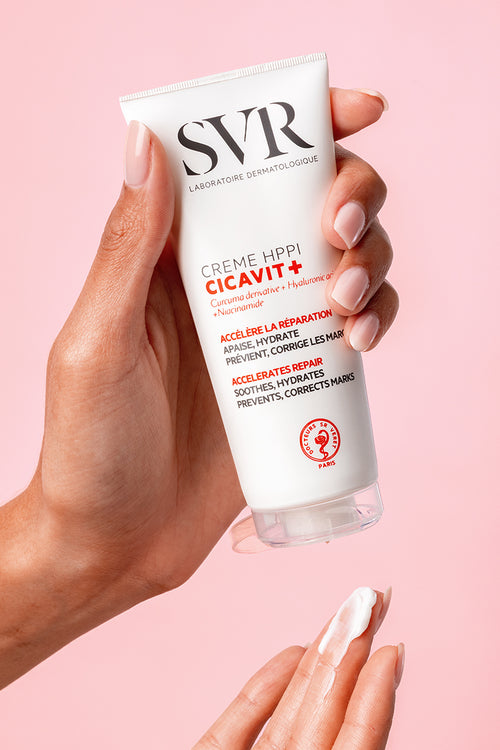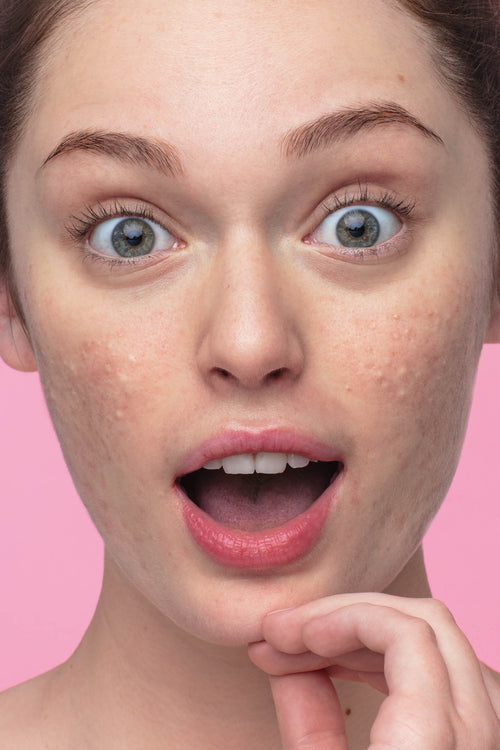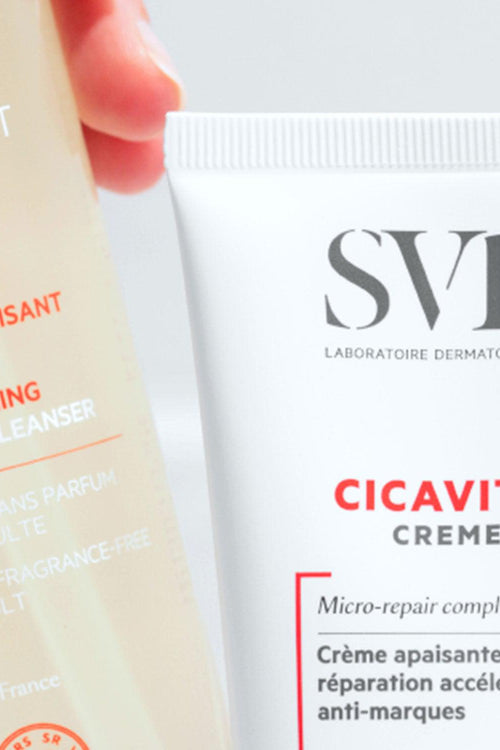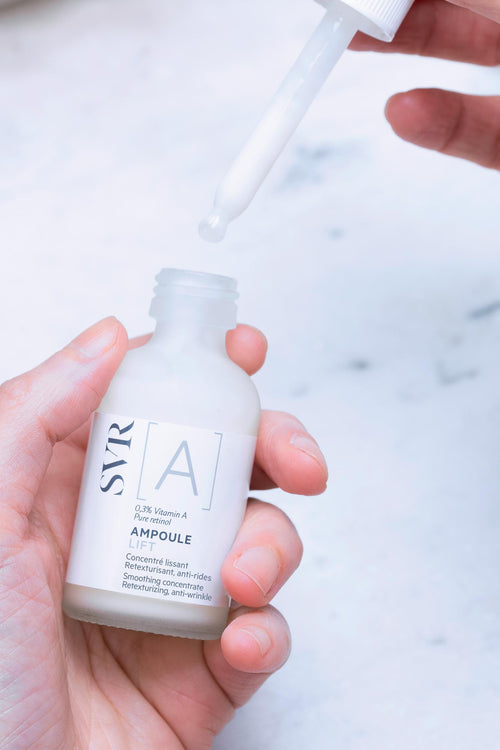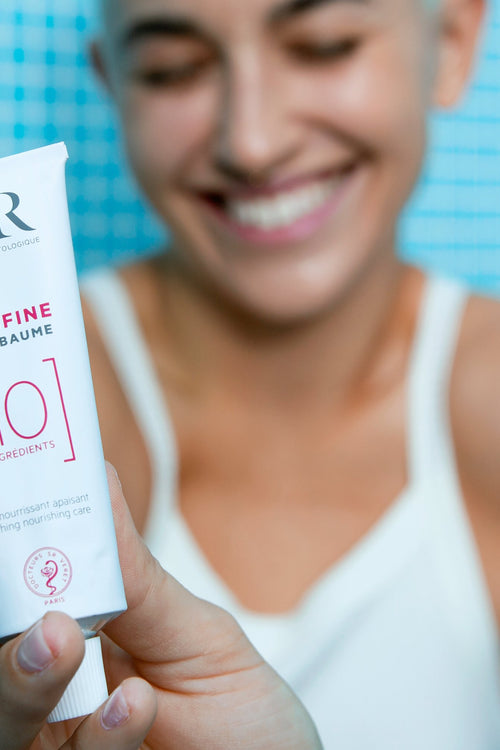We’ve all seen children itching flaming red skin on their elbow creases. According to the French Dermatology Society 20% of children under seven and 15% of babies over three months (1) suffer from atopic dermatitis, which affects the whole family. The condition often lasts into adulthood and affects around 4% (2) of the French population. Worryingly, the number of cases has tripled (3).
What's atopic dermatitis?
According to the “official definition“(4), atopic dermatitis – also known as atopic eczema – is a chronic inflammatory condition of the skin caused by an anomaly in the immune response and a deficient skin barrier.
The symptoms are patches of dry, red, inflamed skin. The inflammation causes itching, which can lead to lesions forming, and sometimes a secondary infection. It takes the form of flare-ups and can be more or less severe (the scale used in France is SCORAD, which stands for Scoring Atopic Dermatitis).
Why does this happen? Healthy skin acts as a defence barrier against external agents. But skin affected by atopic dermatitis has had its fortifications breached, which allows attackers (pathogens) to enter and its defence (moisture) to escape.
What causes it? There is a genetic factor (50-70% of people who suffer from atopic dermatitis have a parent who also suffers from it; if both parents are affected, the risk rises to 80% [5]), an immunity factor (increased sensitivity to certain pathogens) and an environmental factor (such as pollution).
A doctor explains atopic dermatitis
A major impact on quality of life
Atopic dermatitis can be hard to live with.
Young children can suffer from itching around the clock, which disrupts their sleep and waking hours and has a knock-on effect on the whole family. Parents can suffer from distress and guilt as they are unable to soothe their child.
Among older children and teenagers, the visibility of atopic dermatitis can result in teasing and bullying, leading to emotional problems.
Among adults, surveys show that the condition can disrupt sleep and cause ongoing sleep problems (6), leading to problems at work (concentration, performance), lower self-confidence (especially for women with eczema on their eyelids) and even anxiety and depression. It is truly a vicious circle.
What other solutions are there apart from medication?
Emollient creams are essential!
“The best treatment for atopic skin is still daily application of an emollient,” says professor Tennstedt. Studies have clearly shown (7) that their long-term use not only has a beneficial effect on skin dryness, it also reduces the frequency of flare-ups, resulting in less need for topical steroids. The emollient should contain a high concentration of nourishing actives (vegetable oils and butters), soothing ingredients (niacinamide, madecassoside, bisabolol, etc.) and possibly anti-bacterial ingredients to prevent the spread of Staphylococcus aureus.
Children should be taught from a young age to let a parent or carer apply cream to their skin daily without protest, and then to apply it regularly themselves when they are older! Dermatologists must educate families on the correct approach. There are also therapeutic education teams working in hospitals who can ensure patients understand how to care for their skin.
- Thermal spring water treatment
In France, three-week thermal spring water treatments are prescribed by doctors and are covered by health insurance, and have proved effective on conditions such as atopic dermatitis. In addition to providing thermal water treatments (baths, showers, massages) and daily local treatments, these spas offer therapeutic patient education and support. Treatment relieves patients’ symptoms and helps them become more independent in managing the condition. Ten thermal spas are recommended for dermatological treatment in France.
Good habits:
For teenagers and adults who don’t respond to the usual treatments, UVB or combined UVA/UVB therapy can help. However, between 20 and 25 sessions at a frequency of two or three times a week are necessary! These are medical treatments that can only be administered by a dermatologist.
The right gestures:
- Gentle cleansing: use cleansing oils or soap-free dermatological cleansing bars
- Avoid long hot baths, which increase the permeability of skin. A five-minute tepid shower is preferable.
- After showering or washing hands, pat skin dry with a towel. Don’t rub – the skin is already sensitive!
- Children should be educated: during flare-ups, they must be encouraged to avoid scratching with their nails, which could break the skin and spread germs. Instead, they can relieve itching by rubbing with the palm or back of the hand.
- Pure skincare formulas: avoid potentially irritating/allergenic fragrances or preservatives.
- Avoid products and furniture around the home that contain volatile organic compounds (VOCs) including building, decorating and insulation materials, paint, thinners, glues and varnish, cleaning products, air fresheners, stain removers, insecticides and chemical descalers. It isn’t always easy.
- When it comes to clothing, loose is better, to avoid fabrics rubbing against skin. Cotton, linen and silk are preferable to wool.
Is the skin microbiota the way forward?
We have long known that Staphylococcus aureus plays a key role in atopic dermatitis. But in-depth research => the best knowledge (there is not one particular study) into what used to be called skin flora has found that the diversity and balance between the micro-organisms that make up the microbiota prevent colonisation by aggressive species and help defend the skin’s immune system. Since 2012 it has been recognised (8) that eczema is associated with a major imbalance of the microbiota, where bacteria such as Staphylococcus Aureus become predominant. They attach to skin and create a shield, which aggravates eczema flare-ups, dryness and itching. While steroids are still the primary treatment, we are seeing the benefit of creating emollients enriched with actives (pre- and postbiotics) that rebalance the microbiota, reduce the inflammatory factor and prevent infection by Staphylococcus aureus.
(1) ISAAC (International Study of Asthma and Allergies in Childhood) (2) Etude Epi-Aware (Epidemiology of Adults Patients With Atopic Dermatitis). Sanofi Genzyme & Regeneron 2016, PGA (Patient Global Assessment) (3) Dermatite atopique : épidémiologie en France, définitions, histoire naturelle, association aux autres manifestations atopiques, scores de gravité, qualité de vie. E. Mahé. Ann. Dermatol. Venereol. 2005; 132 (4) http://allergo.lyon.inserm.fr/2019_DESC/8.Eczema.pdf (5) https://www.inserm.fr/information-en-sante/dossiers-information/dermatite-atopique-eczema-atopique (6) Patient burden of moderate to severe atopic dermatitis (AD), Simpson EL et al. J Am Acad Dermatol 2016 Mar;74(3): 491–498. (7) Wollenberg A, Barbarot S, Bieber T et al. Consensus-based European guidelines for treatment of atopic eczema (atopic derma-titis) in adults and children: part I. J Eur Acad Dermatol Venereol. 2018 May;32(5):657-682. doi: 10.1111/jdv.14891. (8) Temporal shifts in the skin microbiome associated with disease flares and treatment in children with atopic dermatitis, Kong & al, Genome Research, 2012






